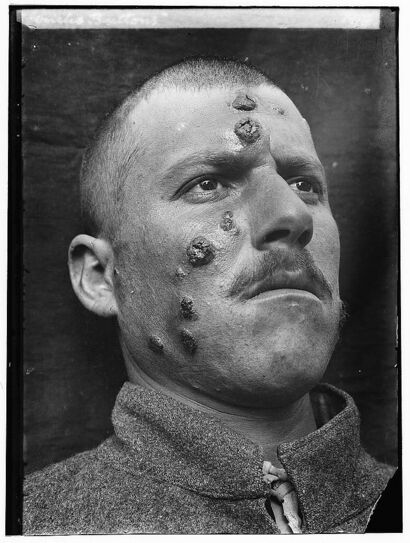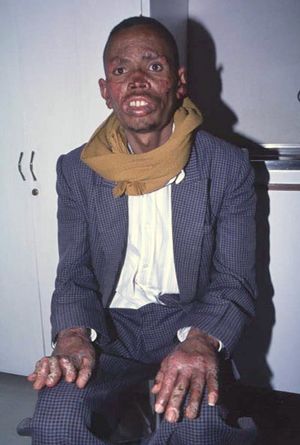داء اللايشمانيا الجلدي
| Cutaneous leishmaniasis | |
|---|---|
| الأسماء الأخرى | Oriental sore, Tropical sore, Chiclero ulcer, Chiclero's ulcer, Aleppo boil, Delhi Boil or Desert boil[1][2][3] |
 | |
| حالة من سنة 1917 لداء الليشمانيا الجلدي في فلسطين، وكان يـُعرف محلياً بإسم "أزرار أريحا Jericho Buttons" لكثرة حدوث المرض بالقرب من المدينة القديمة أريحا. | |
| التخصص | أمراض معدية |

داء اللايشمانيا الجلدي Cutaneous leishmaniasis (وأيضاً تعرف بأسماء "بثور حلب"، "بثور بغداد"، "Bay sore," "زرار بسكرة"، "قرحة تشيكلرو"، "بثور دلهي"، "Kandahar sore," "Lahore sore," "داء الليشمانيا المداري Leishmaniasis tropica," "Oriental sore," "Pian bois," and "Uta"[4]) هو أكثر الصيغ شيوعاً في داء الليشمانيا leishmaniasis. وهو عدوى جلدية تسببها طفيلي وحيد الخلية ينتقل عن طريق عضة ذبابة الرمال. ويوجد نحو 20 نوع من الليشمانيا التي قد تسبب داء الليشمانيا الجلدي.
. . . . . . . . . . . . . . . . . . . . . . . . . . . . . . . . . . . . . . . . . . . . . . . . . . . . . . . . . . . . . . . . . . . . . . . . . . . . . . . . . . . . . . . . . . . . . . . . . . . . . . . . . . . . . . . . . . . . . . . . . . . . . . . . . . . . . . . . . . . . . . . . . . . . . . . . . . . . . . . . . . . . . . . .
العلامات والأعراض
عد دخول الطفيلي يحدث ارتشاح واستنفار للخلايا المناعية (البلاسمية ,اللمفاوية ,الظهارية) فينتج فرط تقرن أنسجة (قساوة أنسجة ) ثم يحصل نخر و تندب وتقرح . تكون فترة الحضانة حسب مناعة الجسم والإصابة 2 أسبوع و حتى السنة.
مراحل المرض:
نميز ثلاث مراحل سريرية:
الحطاطة التوسفية
في مكان دخول الطفيليات يحدث (تجمع –انتباج – احمرار- قساوة) نسميها عقيدة قطرها 1سم يكون لهذه العقيدة قشرة متوسطة هذه الحالة غير حاكة وغير مؤلمة ،قد تشفى خلال أسابيع أو
القرحة القشرية :
تتقيح هذه العقيدة ويسمر لونها من الخارج وترتبط جيدا بالجلد وتكون مؤلمة وتتقرح.
مرحلة الترميم:
سترتشح أو تزول التقيحات(جفاف القرحة) والقشرة المتوسفة السمراء ستزول وستبقى الندبة شكلها البركاني (حوافها مرتفعة والمركز منخفض ) .
- (قد يكون هناك ندب كثيرة جداً ممكن من اللدغات ويمكن ان تكون من تكاثر الطفيلي تحت الجلد،
وتسمى عالميا بحبة حلب Bouton ، حبة دلهي ، حبة بغداد , حبة الشرق ( Oriental boil، L. tropica major ،( L tropica minor و تسببها اللايشمانيا المدارية الكبرى أو الصغرى. هذا المرض الجلدي له أنواع حسب انتشارها
انواع المرض
لايشمانيات العالم القديم (من اللايشمانيات الجلدية )
منها اللايشمانيا المدارية الكبرى تكون ريفية ورطبة أي شكلها رطب متقيح كثيراً أو اللاشمانيا المدارية الصغرى مدنية وجافة الكبرى مستودعها القوارض وتنتشر في آسيا ,إيران ,العراق ,أفغانستان وجنوب شرق روسيا. الصغرى تنتشر في جنوب أوروبا وأفريقيا والشرق الأوسط مستودعها الكلاب . لايشمانيا العالم القديم تكاثر الطفيليات فيها أو تطور المرض(حضانة وتقرحا وشفاء) سريع خلال عدة أشهر (2أسبوع 6 أشهر)
لايشمانيات العالم الجديد :
تنتشر في ( أمريكا وأمريكا اللاتينية)
- اللايشمانيا المدارية المكسيكية :L. tropica mexicanus
تعطي قرحة Ulcer Chiclero ،ولكنها أصغر فقطرها 0,5 سم تطورها أبطأ يصل إلى سنة إلا إذا أصابت منطقة الأذن لأنها تتعشق منطقة الأذن ويمكن أن تصل إلى الصيوان وتحدث تخرب و تآكل في كامل خلايا الأذن .
- في أمريكا اللاتينية والجنوبيةL.piruviansis/ braziliensis/amrcanus تسبب قرحة (Uta Ulcer) جافة وغير متقرحة.
- داء اللايشمانيا الجلدي المنتشر:L.tegumentaire diffuse
ينتشر في فنزويلا وأثيوبيا تسمى Pifano. منتشر ومعمم على الجلد ، إلا أنها حطاطات غير منتظمة جلدية تختفي لكن ببطء شديد. المستودعات حيوانات صغيرة Agotti أو القرود . تطور المريض بطيء جداً لعدة سنوات
المعالجة
The evidence for optimal treatment of cutaneous leishmaniasis is patchy. Treatments that work for one species of leishmania may not work for another; it is recommended that advice of a tropical medicine or geographical medicine specialist be sought. Ideally, every effort should be made to establish the species of leishmania by molecular techniques (PCR) prior to starting treatment. In the setting of a developing country, there is often only one species present in a particular locality, so it is usually unnecessary to speciate every infection. Unfortunately, leishmaniasis is an orphan disease, and almost all the current treatment options are toxic with significant side-effects.
- Leishmania major
- L. major infections are usually considered to heal spontanously and do not require treatment, but there have been several reports of severe cases caused by L. major in Afghanistan. In Saudi Arabia, a six week course of oral fluconazole 200mg daily has been reported to speed up healing.[5]
- Leishmania (Viannia) braziliensis
- Treatment with pentavalent antimonials or amphotericin is mandatory, because of the risk of developing disfiguring mucocutaneous lesions.
- Leishmania infantum
- L. infantum causes cutaneous leishmaniasis in southern France.[6]
New treatment options are arising from the new oral drug Miltefosine (Impavido) which has shown in several clinical trials to be very efficient and safe in visceral and cutaneous leishmaniasis. Recent studies from Bolivia show a high cure rate for mucocutaneous leishmaniasis. Comparative studies against pentavalent antimonials in Iran and Pakistan are also beginning to show a high cure rate for L.major and L.tropica. It is registered in many countries of Latin America (e.g., Colombia), as well in Germany, the home country of its developer Zentaris GmbH. In October 2006 it received orphan drug status from the US Food and Drug administration. The drug is generally better tolerated than other drugs. Main side effects are gastrointestinal disturbances in the 1–2 days of treatment which does not affect the efficacy.
Secondary bacterial infection (especially with Staphylococcus aureus) is common and may require antibiotics. Unfortunately, clinicians who are unfamiliar with cutaneous leishmaniasis may mistake the lesion for a pure bacterial infection (especially after isolation of S. aureus from bacterial skin swabs) and fail to consider the possibility of leishmaniasis.
انظر ايضا
الهامش
- ^ Calvopiña M, Martinez L, Hashiguchi Y (August 2013). "Cutaneous leishmaniasis "chiclero's ulcer" in subtropical Ecuador". The American Journal of Tropical Medicine and Hygiene. 89 (2): 195–6. doi:10.4269/ajtmh.12-0690. PMC 3741233. PMID 23926136.
- ^ Stowers JH (1920). "Case of Delhi Boil or Sore (Syn.: Oriental Sore; Aleppo Boil)". Proceedings of the Royal Society of Medicine. 13 (Dermatol Sect): 81–3. doi:10.1177/003591572001300351. PMC 2152205. PMID 19980989.
- ^ The Institute for International Cooperation in Animal Biologics and the Center for Food Security and Public Health (October 2009). "Leishmaniasis (cutaneous and visceral)" (PDF). Ames, Iowa: College of Veterinary Medicine, Iowa State University. Retrieved 2015-01-04.
- ^ James, William D.; Berger, Timothy G., et al. (2006). Andrews' Diseases of the Skin: clinical Dermatology. Saunders Elsevier. ISBN 0-7216-2921-0.
{{cite book}}: Explicit use of et al. in:|author=(help)CS1 maint: multiple names: authors list (link) - ^ Alrajhi AA, Ibrahim EA, De Vol EB, et al. (2002). "Fluconazole for the treatment of cutaneous leishmaniasis caused by Leishmania major". N Engl J Med. 346 (12): 891–95. doi:10.1056/NEJMoa011882. PMID 11907288.
{{cite journal}}: Explicit use of et al. in:|author=(help)CS1 maint: multiple names: authors list (link) - ^ Pratlong F., et al. (2004). "Isoenzymatic analysis of 712 strains of Leishmania infantum in the south of France and relationship of enzymatic polymorphism to clinical and epidemiological features". Journal of Clinical Microbiology. 42 (9): 4077–82. doi:10.1128/jcm.42.9.4077-4082.2004. PMC 516332. PMID 15364993.
{{cite journal}}: Explicit use of et al. in:|author=(help)